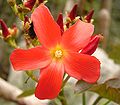Jatropha
| Jatropha subsp. var. | ||||||||||||||||||||||||||||||||||||||||||||||||||||||||
|---|---|---|---|---|---|---|---|---|---|---|---|---|---|---|---|---|---|---|---|---|---|---|---|---|---|---|---|---|---|---|---|---|---|---|---|---|---|---|---|---|---|---|---|---|---|---|---|---|---|---|---|---|---|---|---|---|

|
|
| ||||||||||||||||||||||||||||||||||||||||||||||||||||||
| ||||||||||||||||||||||||||||||||||||||||||||||||||||||||
| Standard Cyclopedia of Horticulture |
|---|
|
{{{1}}} The above text is from the Standard Cyclopedia of Horticulture. It may be out of date, but still contains valuable and interesting information which can be incorporated into the remainder of the article. Click on "Collapse" in the header to hide this text. |
Jatropha is a genus of approximately 175 succulent plants, shrubs and trees (some are deciduous, like Jatropha curcas L.). The name is derived from Greek, and has the common name physic nut. Jatropha is native to Central America[1] and has become naturalized in many tropical and subtropical areas, including India, Africa, and North America. The mature small trees bear separate male and female flowers, and do not grow very tall. As with many members of the family Euphorbiaceae, Jatropha contains compounds that are highly toxic.
The hardy Jatropha is resistant to drought and pests, and produces seeds containing 27-40% oil.
Cultivation
Outdoors: likes moderately rich soil, with humus, and some grit for good drainage. Plant in full sun.
Indoors under glass: 2 parts potting mix (soil based) to one part grit and one part leaf mold. Give strong light, but protect from hot sun under glass. Water moderately in Spring/Summer, with monthly fertilizer, and keep very dry in Fall/Winter.
Propagation
Seed should be sown in Spring or Summer at 74F (25C).
Pests and diseases
Susceptible to mushroom root rot, rust, fungal leaf spot, scale insects, mealybugs.
Species
Species of Jatropha include:
- Jatropha cuneata limberbush, whose stems are used for basketmaking by the Seri people in Sonora, Mexico, who call it haat.
- Jatropha curcas, also known as physic nut, piñoncillo and Habb-El-Melúk, is used to produce the non-edible Jatropha oil, for making candles and soap, and as a feedstock for producing biodiesel.
- Jatropha gossypifolia, also called bellyache bush: its fruits and foliage are toxic to humans and animals. It is a major weed in Australia.
- Jatropha integerrima Jacq., or spicy jatropha: ornamental in the tropics, continuously crimson, flowers almost all year.
- Jatropha multifida L., or coral plant: bright red flowers, like red coral, charactertised by strongly incised leaves.
- Jatropha podagrica or buddha belly plant or bottleplant shrub was used to tan leather and produce a red dye in Mexico and the Southwestern United States. It is also used as a house plant.
Synonyms -- This genus is also known as: Adenorhopium Rchb., Adenoropium Pohl, Aamanakku / Kaattaamanakku Tamil, India, Castiglionia Ruiz & Pav., Collenucia Chiov., Curcas Adans., Jarak Indonesia, Jatropa Scop., orth. var., Loureira Cav., Mesandrinia Raf., Mesandrinia Ortega, Zimapania Engl. & Pax, Nkran Dedua, Pourghère French term, Pulga, Tempate
Toxicity
Characteristic of many members of the family Euphorbiaceae, Jatropha plants contain several toxic compounds, including lectin, saponin, carcinogenic phorbol, and a trypsin inhibitor. Despite this, the seeds are occasionally eaten after roasting, which reduces some of the toxicity. Its sap is a skin irritant, and ingesting as few as three untreated seeds can be fatal to humans. In 2005 Western Australia banned Jatropha gossypifolia as invasive and highly toxic to people and animals.
Gallery
in Hyderabad, India.
in Hyderabad, India.
in Hyderabad, India.
References
- ↑ Fairless D. (2007). "Biofuel: The little shrub that could - maybe". Nature 449: 652–655. doi:10.1038/449652a.
- Standard Cyclopedia of Horticulture, by L. H. Bailey, MacMillan Co., 1963
External links
- w:Jatropha. Some of the material on this page may be from Wikipedia, under the Creative Commons license.
- Jatropha QR Code (Size 50, 100, 200, 500)



















